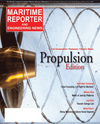
Page 38: of Maritime Reporter Magazine (September 2011)
Marine Propulsion Annual
Read this page in Pdf, Flash or Html5 edition of September 2011 Maritime Reporter Magazine
and, wind, steam and motor power the four basic types of marine propulsionare familiar to all maritime experts. Ex- actly when the combustion engine was first used for ship propulsion is, however, largely unknown. This is not particularly surprising, seeing that it took more than50 years for the diesel engine to finally replace the steam engine. The diesel en- gine was not the forerunner in the history of motorised shipping, as is wronglystated in various sources; this was in fact the Otto engine. The decisive factor for the success of the combustion engine as a marine drive was finding a motor type with development potential, and such an engine was invented by Nicolaus August Otto in 186 in Cologne. Further devel- opmental work resulted in the fastrunning engines of Carl Ben and ottlieb Daim- ler. Both were granted a patent in 1886 with a direct reference to their use forship propulsion. The specification of Deutsches eichspatent DP 5 Automobile fuelled by gas, issued to Ben Cie. on 29 January 1886, states This construction is intended for the op-eration mainly of light carriages andsmall boats, such as those used to carry 1to persons. One year later, Ben was already building ship drives, thus estab- lishing a tradition in the city ofMannheim. While the Ben patent was generally directed at powering road vehi- cles, ottlieb Daimler soon afterwards applied for a patent describing a device for driving the propeller shaft of a ship by gas or by a petroleum engine, which was granted on 9 October 1886 (DP 96). In respect of the practical implementationof engine technology, Daimler was quicker than Ben in August 1886, he was already conducting his first trials on the river Neckar. SEAN SPS W ENNES At the time, the terms gas engine and gaspowered motor referred to the Otto engine, a spark ignition device. The pe- troleum engine, which soon came into use, was from 1890 a hot bulb engine in- vented by erbert Akroyd Stuart, an Eng- lishman. Owing to the relatively low power of the first units, they were initially used for the propulsion of inland water- way vessels. The hot bulb engines, which primarily operated in twostroke mode, soon offered adequate power for small seagoing ships and proved reliable for fishing vessels and as an auxiliary drive for sailing ships. This type remained in use up until the 190s. During the transi- tional phase from the Otto to the dieselThe Engine of Progress FEATURE MARINE PROPULSION125 years of motor shipping: from humble beginnings to completely replacing of the steam engine Jahre Motorschiffahrt MAN Selandia. (Copyright MAN)Jahre Motorschiffahrt Monte Pnedo 38Maritime Reporter & Engineering News (Copyright Wärtsilä)

 37
37

 39
39
